Mike Vardy's Blog, page 51
May 23, 2018
Getting Back to Happy with Marc and Angel Chernoff
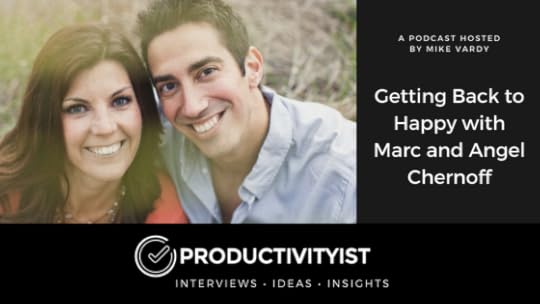
On this episode of the podcast, I spoke with Marc and Angel Chernoff. Marc and Angel are the authors of the new book Getting Back To Happy: Change Your Thoughts, Change Your Reality and Turn Your Trials Into Triumphs. We spoke about happiness, overcoming adversity and the role rituals play in our happiness. We also did a self-inquiry session which I found very insightful. It was a great conversation, I hope you enjoy it too.
Here are a few highlights from the show:
We are what we do on a daily basis
The importance of rituals as a way to move forward
Why rituals are a solid foundation for mindfulness and other tools
How Marc and Angel work together
The power of self-inquiry by journaling on the most stressful experiences
Our thoughts and the way we think are the stories we tell ourselves
98% of the time, the problem is not the problem, it is something deeper
Recording your thoughts, then reviewing them to bring awareness
Whatever you’re seeing is an interpretation of what you’re thinking
Ways to have lasting benefits such as visual reminders and accountability
Accountability using your own questions and having someone read them to you
Relevant Links:
Marc and Angel’s Blog
Getting Back to Happy: Change Your Thoughts, Change Your Reality, and Turn Your Trials into Triumphs
6 Tiny Daily Rituals That Will Change Your Life
Thanks for listening. If you enjoyed the show don’t forget to subscribe so you don’t miss a single episode. Until next time remember to stop guessing…and start going!
If you’re interested in supporting the podcast and receiving exclusive content while doing so, you’ll want to check out the patrons-only version of The Productivityist Podcast on Patreon. Also, remember to leave The Productivityist Podcast a rating and review on iTunes, or on whatever platform you’re listening to. I read every single bit of feedback we receive. I want to make this show better and with your help I can do that. If you’d just like to support the podcast on its own, you can do so here.
The post Getting Back to Happy with Marc and Angel Chernoff appeared first on Productivityist.
May 16, 2018
Morning Routines with Benjamin Spall
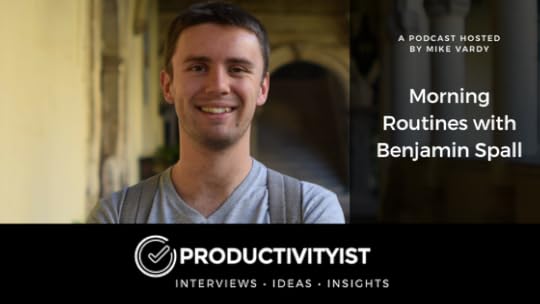
On this episode of The Productivityist Podcast, I speak with Benjamin Spall. Benjamin is the co-author of My Morning Routine: How Successful People Start Every Day Inspired, and the founding editor of the blog of the same name.
During our discussion we touch on how morning routines are important to both early risers and night owls alike, what was discovered about routines during the research for the book, what he has taken from some of the routines that are in the book (and from the website as well), and more.
The book reads like a solid reference book – a lot like Tim Ferriss’s Tools of Titans – and it’s a worthy addition to any bookshelf. Whether you use it to establish a solid routine or use it to find things to add or subtract to your own routines.
Relevant Links:
My Morning Routine: How Successful People Start Every Day Inspired | Amazon
Mike Vardy’s Morning Routine | My Morning Routine
My Morning Routine on Facebook
My Morning Routine on Twitter
Thanks for listening. If you enjoyed the show don’t forget to subscribe so you don’t miss a single episode. Until next time remember to stop guessing…and start going!
If you’re interested in supporting the podcast and receiving exclusive content while doing so, you’ll want to check out the patrons-only version of The Productivityist Podcast on Patreon. Also, remember to leave The Productivityist Podcast a rating and review on iTunes, or on whatever platform you’re listening to. I read every single bit of feedback we receive. I want to make this show better and with your help I can do that. If you’d just like to support the podcast on its own, you can do so here.
The post Morning Routines with Benjamin Spall appeared first on Productivityist.
May 9, 2018
All Things Productive with Carl Pullein
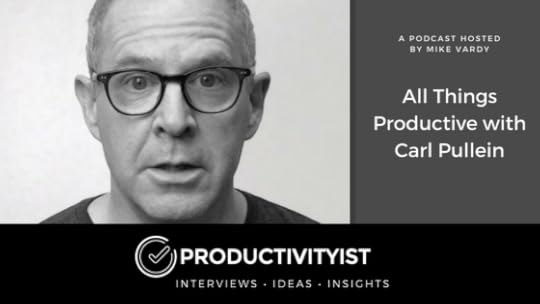
On this episode of the podcast, I spoke with Carl Pullein. Carl is a personal productivity specialist, presenter and author of Your Digital Life and Working With Todoist: The Book. We spoke about the term “productivity,” how to get the most out of applications and more.
Here are a few highlights from the show:
What productivity means
Why it’s so important to capture quickly
How culture affects perspective and productivity
What “hard edges” are and why it’s so important to productivity
Using tools for their designed purpose
The problem with having too many choices
Why it can be great to stick with one app that has a specific purpose
Why approach is more important than application
We tend to overcomplicate applications
Relevant Links:
Carl Pulein
Your Digital Life & Working with Todoist
How to Turbo-Charge Your Productivity by Using Hard Edges and Single Apps
You Have a Choice and That’s the Problem
Why the Front End Work is Essential if You Want to be Productive
Thanks for listening. If you enjoyed the show don’t forget to subscribe so you don’t miss a single episode. Until next time remember to stop guessing…and start going!
If you’re interested in supporting the podcast and receiving exclusive content while doing so, you’ll want to check out the patrons-only version of The Productivityist Podcast on Patreon. Also, remember to leave The Productivityist Podcast a rating and review on iTunes, or on whatever platform you’re listening to. I read every single bit of feedback we receive. I want to make this show better and with your help I can do that. If you’d just like to support the podcast on its own, you can do so here.
The post All Things Productive with Carl Pullein appeared first on Productivityist.
May 2, 2018
Purpose Mapping with Craig Filek
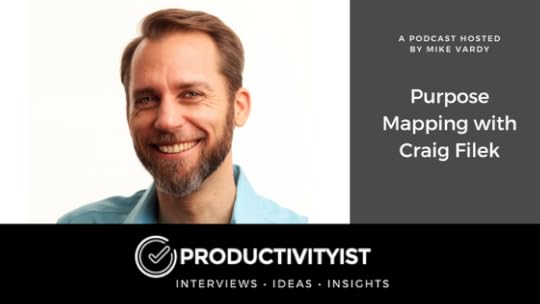
On this episode of the podcast, I spoke with Craig Filek. Craig is Executive Director of the Purpose Genome Institute and the creator of Purpose Mapping. He helps high-achievers realize their full potential by clarifying their purpose, aligning with their flow state, and making a meaningful contribution every day. We spoke about Purpose Mapping, how it provides users with valuable insights, and how it aligns with personal productivity.
Here are a few highlights from the show:
We spoke about the concept of “flow”
How boundaries reinforce flow
Why it’s important to double down on the things you really do well
How Craig’s personal journey lead to the creation of Purpose Mapping
How your purpose and mission relates with your day-to-day life
Moving past the “Golden Hamster Wheel”
Why the areas you struggle with are important to your breakthrough
Relevant Links:
Purpose Mapping: The Dirty Little Secret of Every High-Achiever
The Productivityist Podcast: Beyond the E-Myth with Michael E. Gerber | Productivityist
Craig Filek | Twitter
Thanks for listening. If you enjoyed the show don’t forget to subscribe so you don’t miss a single episode. Until next time remember to stop guessing…and start going!
If you’re interested in supporting the podcast and receiving exclusive content while doing so, you’ll want to check out the patrons-only version of The Productivityist Podcast on Patreon. Also, remember to leave The Productivityist Podcast a rating and review on iTunes, or on whatever platform you’re listening to. I read every single bit of feedback we receive. I want to make this show better and with your help I can do that. If you’d just like to support the podcast on its own, you can do so here.
The post Purpose Mapping with Craig Filek appeared first on Productivityist.
April 30, 2018
The One Meeting I Make Time for No Matter What
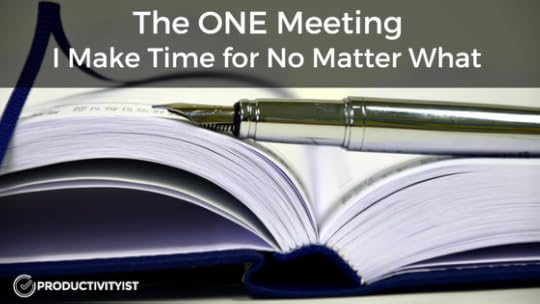
My wife and I have a lot going on. We work together on this business of mine, and Anne has her own business dealings as well. We also have two kids, so we have other people in our household that require our time, attention, and focus. As our kids have gotten older, their needs have changed, so nothing at home really stays the same.
In fact, nothing about our lives ever really stays the same. In the past, whenever my wife and I had time together, we would use those fleeting moments to talk about what each of us had going on that the other needed to know about. Things like who was going to cook dinner over the next few days, what elements of this business needed discussion, and how we were going to attend our daughter’s school concert while still keeping our son entertained.
By the time we would discuss these different areas of our lives, our brief moments together were spent. The demands of our lives came calling, and we headed off in different directions to deal with them. At the end of the day we wanted to passively be together in the same room without anything other than the occasional glance at each other.
I wanted to be more intentional about the moments we spent together.
A Small But Intentional Change
Essentially, I wanted to bring elements of what I believe and teach about personal productivity to this area of our lives. After much discussion, I found a way to allow my wife and I have moments of deliberate household and business management rather than having scattered conversation at random times throughout the week. Now we spend time together where we just enjoy each other’s company with little to no agenda at all.
Basically, I have a meeting with my wife every week where we discuss those things we must consider on a regular basis to run our lives, our family, and our businesses better. Where we discuss things like meal planning, fiscal responsibilities, and other elements of creating a happy and healthy home life.
I call it The F’ing Meeting. And it is the most valuable meeting I have on my schedule.
How The F’ing Meeting Works
The way the meeting works is that my wife and I schedule it at minimum once every two weeks. We try to have it every week, but due to travel schedules and such, that isn’t always possible. The F’ing Meeting takes place at the same time on the same day every time. I look at it as something that is unmovable. Again, if we can’t meet weekly, then it’s better for us to skip the week then to try to move it to another day. Consistency is the key here.
We don’t necessarily prepare a typical agenda, but there are three categories that we cover during each meeting. They are as follows:
1. Food
2. Finance
3. Family
Because I work from home and I’m an entrepreneur all three of these topics work for both business and home life. Let’s look closer at each area.
Food
When it comes to this topic, we tend to review things like meal planning, grocery shopping, and any scheduling issues that will affect meals over the next two weeks.
For example, if both kids have some sort of event going on after school, that shortens the amount of time we would have to cook something. We may need to cook something either in advance or use the Instant Pot to have a cooking for a longer period of time throughout the day. In addition, I tend to use my sous vide cooker while I am spending time with the kids. That way I don’t have to concern myself with watching the food while it cooks.
As you can imagine, we review recipes first and then put the grocery together. There have been moments where we have considered using a service like Geoff Pages hectic meals for planning – and it is something we regularly consider to this day. However, even if you have a resource like that sitting down to discuss meal planning is something that allows us to save time, money, and energy throughout the week.
Finance
The topic of finance actually bleeds over into the first one. After all, if our finances aren’t sorted out, then we have no idea what we can spend on groceries, right? That’s why we don’t necessarily cover all of these topics in the order I have listed them. But I’ll talk about that more in a bit.
When we get to this area the conversation, we start to talk about the financial situation for both the business and for our family. This topic can lead to a long conversation at times, but because we have done it so consistently and regularly, the time spent on the subject tends to get shorter over time.
A great byproduct of this meeting is that we can actually use our regular financial discussions to feed greater ones, such as what we want to do for travel or improvements we would like to make around the house.
My wife is definitely better with money than I am. However, by making this a topic of discussion during our meetings, I am becoming better with money as well. It’s definitely more of a challenge for me, but I find it these regular meetings help. If anything, they foster awareness. And that’s a great first step.
Family
While the other two subjects have something to do with family, spending time on this category is more about what each member of the family has going on over the next week or so.
Things like field trips for the kids, travel for myself, outings for any of us, are brought up during this part of the meeting. To be honest, this is the subject that seems to have the least amount of time spent on it during the meeting, but without it in place, I’m sure things would definitely fall through the cracks.
I would say they’re out of the three areas, this is the one that we discussed first. It’s short, it leaves the foundation for the other two areas, and it places importance on the most important reason we are having these meetings in the first place: each and every member of the household.
What The F’ing Meeting Offers
Investing attention on these three areas of our lives creates a compounding effect that ultimately results in a fourth “F”: Focus.
No longer do I need to wonder what we’re having for dinner. We’ve planned that far in advance. We have a greater understanding of our money situation now because of this regular meeting – something I’ve never had before. We can keep our spending aligned with our long-term goals for both work and family. We’re both in the loop about family activities. I know when I need to be somewhere, as does my wife. Admittedly, I was in need of this component far more than Anne was. But the result of this has been an increased awareness for me about why I craved the freedom and flexibility that entrepreneurship can offer…so I can spend more time with those I love.
As I mentioned earlier, we don’t necessarily discuss the three areas in the order I listed them. Sometimes we need to discuss money before food. Sometimes we need to discuss family before food. We have some variety built into the framework because many of these areas have an “if/then” component.
The best thing the meeting has done is afforded my wife and I time to just go out and date. We do not have to concern ourselves with talking about home and business endlessly. We cover that stuff during these meetings instead. So when my wife and I want to have a date night, we are able to focus on the date and each other.
Meetings don’t have to be a waste of time. I would go as far to say that a lot of meetings that you have aren’t. But if you want to have one of the more meaningful meetings you could have, consider having this one. It is well worth your time.
The post The One Meeting I Make Time for No Matter What appeared first on Productivityist.
April 25, 2018
The Workcation Weekend with Holly Worton
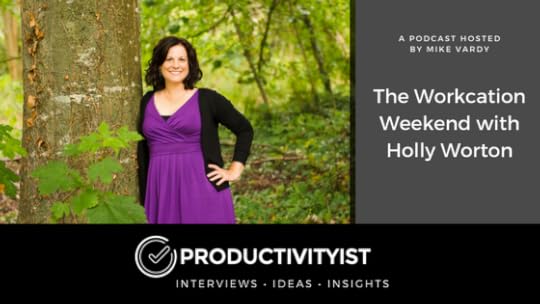
On this episode of the podcast, I spoke with Holly Worton. Holly helps entrepreneurs dissolve their blocks and limiting beliefs around money and success. We discussed how Holly has a “Workcation Weekend” at a hotel once per month and uses this time to write books, rebrand her website and more.
Here are a few highlights from the show:
How Holly uses what she calls “hyperfocus” by freeing herself from distraction
Why she goes to the same hotel for Workcation Weekends and has the same food
How to take a Workcation Weekend with kids
How Holly prepares for her time away
Why it’s helpful to plan ahead for your bookends of the workweek
The approach Holly uses to avoid burnout
How to set aside time to have your own Workcation Weekend
Relevant Links:
Holly Worton | Business Mindset Alchemist
The Definitive Guide to the Workcation Weekend | Business Mindset Alchemist
Books by Holly Worton | Business Mindset Alchemist
How I Write | Business Mindset Alchemist
Resources | Business Mindset Alchemist
Thanks for listening. If you enjoyed the show don’t forget to subscribe so you don’t miss a single episode. Until next time remember to stop guessing…and start going!
If you’re interested in supporting the podcast and receiving exclusive content while doing so, you’ll want to check out the patrons-only version of The Productivityist Podcast on Patreon. Also, remember to leave The Productivityist Podcast a rating and review on iTunes, or on whatever platform you’re listening to. I read every single bit of feedback we receive. I want to make this show better and with your help I can do that. If you’d just like to support the podcast on its own, you can do so here.
The post The Workcation Weekend with Holly Worton appeared first on Productivityist.
April 23, 2018
Your Email App is Not Your To Do List
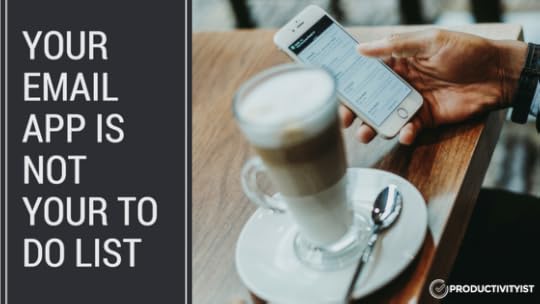
Let me get this out of the way: Emails do not always include tasks within them.
I want to clarify this point because it’s important to recognize that when you receive an email, it may not require any further action. It may just be a piece of information that stands on its own. You may want to create a task based on the email, such as a follow-up or a reminder to review the contents of the email. But the email itself is not a task.
That’s why I can safely say that your email app is not your to do list. Instead, it feeds your larger to do list.
Unless you make your email inbox your entire to do list.
Setting that up would involve sending yourself emails for tasks you want to complete, plug-ins that create scheduling options, the categorization of emails into many folders, and so on.
I think, however, making your email app your to do list – other mistakenly or intentionally – is unwise.
But why?
The Configuration
Email apps aren’t designed like task apps. They aren’t even designed like paper planners – at least not by default. The user has to spend time and energy putting folders and categories in place.
But there are things that you just can’t do in terms of configuration with an email app.
You can’t really create a scheduling system in email. Sure, you can use folders in the same way that I use them for my email workflow, but that isn’t nearly as effective as using a to do list app for those sort of things.
There are no repeating task options in email out of the box. Tagging emails can become cumbersome. And even if you can, the meaning behind them can get lost whereas with a to do list app there is a lot more transparency.
Bottom line: an email program has different architecture and design than a to do list program. Using an email app with its current configuration or with additional plug-ins still won’t be as effective in the long run as a dedicated to do list app. The reasoning is simple: it just isn’t designed for that.
So rather than spend time trying to make your email program into a to do list program, wouldn’t it just be best to get an actual to do list program? When you have an intentional framework in place, you’ll spend less time in email and more time doing the work that matters to you.
The Constraints
Because there are limitations in the configuration of email apps, there are greater constraints. Again, you can work around them, but that mindset requires more discipline on the user’s part than anything else.
Plus those constraints can actually slow down progress rather than speed it up.
One of the reasons people tell me they like to use their email application as their to do list is that they don’t have to switch between apps. They can do everything that they need to do inside of their email app. But, again, not every email contains a task inside of it. So what do you do when you have tasks that don’t come in via email? Do you send yourself an email? If so, how do you organize them in a way that allows you to see what you’re directing yourself to do over what others are directing you to do?
Interestingly, these constraints actually create friction because there is more uncertainty about what is going on inside of your email app when everything is in it. If you use an email app and a to do list app (or paper planner), then there is more certainty about what is inside of each of them.
The best constraint that an email app has is that it is designed to handle email incredibly well. Email apps can manipulate your messages and filter them and do almost anything with every email you receive. And that includes moving them to your to do list application of choice in a lot of cases. When you use your email app as just that, those constraints work for you.
But when you try to do more with it, they definitely can work against you.
The Connection
When you use email as your primary to do list (or master list), you are constantly connected to others. Anyone can email you at any given time, so if you’re working in your email app all of the time you are susceptible to the disruptions that can cause.
Those disruptions don’t just happen when an email lands in your inbox, either. There’s always this subconscious element lurking in your mind, knowing that an email could disrupt and divert your flow at any given moment. Working in your email app all the time keeps you one step closer to connecting with others when it would be far better to connect deeply with yourself and your own work.
Even if your job is to deal with emails a lot, having a place where your non-email related tasks can live (a to do list app, a paper planner, etc.) allows you to better connect with those tasks as they will stand out from anything email-related.
The Email Challenge
If you think it is not possible to wean your constant connection to your email program for any length of time, I challenge you to try the following for just one day.
1. Grab a blank piece of paper, date it, and write down 3-5 tasks you need and/or want to do on that date.
2. Work your day as usual but add any tasks that come in via email to the sheet as they arrive instead of just leaving them to percolate in your email app.
3. When you have a break (or breath) between emails instead of scouring them for tasks, look at the sheet you made.
4. Do just ONE of those things for a set amount of time – try 15 minutes at minimum – and hide your email app from plain sight. (BONUS: Snooze your notifications for that duration of time as well so they don’t distract you.)
5. Repeat this throughout the day until either the day is done or your list of tasks are.
6. Flip the sheet over and write down how it felt to work like this for the day.
I’d love to hear how this exercise goes – the good and the not-so-good – so email me your findings by contacting me here. I may not be able to respond to you, but I’ll try.
Move Forward Mindfully
If you decide that you would like to change your approach to email, then I have one last bit of it for you: don’t try to do this all at once.
Try the exercise I mentioned above first. Try it for one day a week, and then add more days over the next couple of weeks. The best way for you to recognize that this will work for you is to see qualitative and quantitative results. You want to feel like you are doing more of the things you really need and want to do. Often times email doesn’t contain those kind of tasks – at least not qualitative ones – largely because not everything that comes into email is a task.
And that’s because most of the qualitative tasks that you need to work on are coming from you.
Sure, they may be coming from someone else initially, but you are the one that is setting them as intentions. Then you are deciding when you’re going to give them your attention.
Making this kind of shift is not going to happen overnight. It’s going to take time. Anything worthwhile really does. But you’ve got to stick with it. And if you try to do it all at once, it’s going to seem so daunting that you’re likely to give up.
Give yourself the best chance possible to do this. Start slowly and deliberately. Chronicle your progress. Build from there.
Keeping your email app separate from your master to do list will help you see clearly the lines of communication you have between others and yourself. You’ll be able to do tasks on both lists with more focus and attention than before.
And you’ll be able to get email out of your way when the time is right for you.
The post Your Email App is Not Your To Do List appeared first on Productivityist.
April 18, 2018
The Link Between Personal and Professional Productivity with Mark Lavercombe
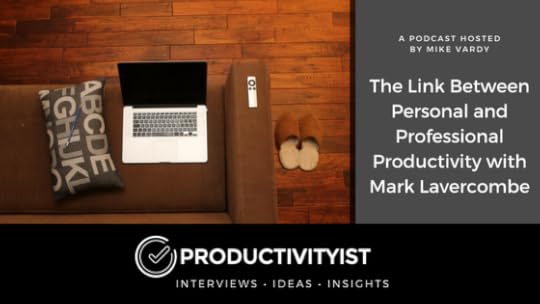
On this episode of the podcast, I spoke with Dr. Mark Lavercombe. Mark is a specialist physician and medical educator, who writes on productivity, clinical education and leadership at The Productive Physician. We spoke about how he defines productivity, how he became passionate about productivity, how he sets boundaries and more.
Here are a few highlights from the show:
Why misdiagnoses are common
Know why you are doing something is essential
How good assumptions can actually lead to bad habits (such as leaving email open)
The balance between being reactive and proactive
Identifying what you want to achieve as well as why you want to achieve it
Linking motivation with the emotional and intellectual basis for goals helps clarify thinking
Making time for yourself
Setting boundaries according to rules that you establish
Relevant Links:
The Productive Physician
Why Productivity for Physicians
Create a Personal Mission Statement for the LIFE YOU want
Do You Want an Extraordinary Life? Choose Deep Work
@ProductivePhys | Twitter
Thanks for listening. If you enjoyed the show don’t forget to subscribe so you don’t miss a single episode. Until next time remember to stop guessing…and start going!
If you’re interested in supporting the podcast and receiving exclusive content while doing so, you’ll want to check out the patrons-only version of The Productivityist Podcast on Patreon. Also, remember to leave The Productivityist Podcast a rating and review on iTunes, or on whatever platform you’re listening to. I read every single bit of feedback we receive. I want to make this show better and with your help I can do that. If you’d just like to support the podcast on its own, you can do so here.
The post The Link Between Personal and Professional Productivity with Mark Lavercombe appeared first on Productivityist.
April 16, 2018
How I Added Flexibility and Freedom to My Weekends
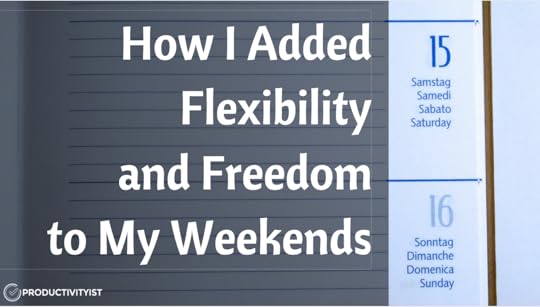
“About those weekend daily themes, Mike…”
That’s what my wife interjected with as she drove me to the airport while I talked about plans for some weekends in the future. I was heading off to a speaking engagement for a few days. Once I got home, she’d be heading out of town for a few days. The weekends throughout the month were going to be out of the ordinary with only one of us would be home with the kids. But once the next month arrived, we’d have our family life back to a sense of normality again and we could resume with Saturdays and Sundays as usual.
That meant my usual themes for those days would affect the family again too.
How I’ve Themed My Weekends
Saturdays have long been my days for focusing on family. There are several things I aligned with this theme, including:
Leisure time with my immediate family
Socializing with friends and family
Household chores and maintenance
Errands for the home
There are other types of tasks that fall into this theme, but the ones I have showcased above cover a lot of them. The kids have gotten so used to Saturdays being associated with leisure time that when they would ask when we could do things like see the latest superhero movie or have a family outing, they would actually ask what Saturday instead of what day we could do them. They knew that by specifically mentioning a Saturday that the likelihood of getting to do what they wanted would be higher than attaching it to another day of the week.
I emphasize tasks that involve planning on Sundays. Sunday is the start of my week because of its positioning on most paper-based calendars. I also know there are fewer disruptions since most people don’t send emails or work very much on Sundays. By leveraging that I can map out my week and prepare for the days ahead. My family members do their own thing on Sunday while I work – and since I only work partial days on Tuesdays and Wednesdays by picking up my son from school – I make up for that time on Sundays.
New Insights
I think my wife has been approving and/or tolerant of how I theme the days of the weekend since I started doing it because it gives me clarity (which affords focus) on those days. I definitely want to “walk the talk” when it comes to Daily Theming (and TimeCrafting as a whole) so theming every day of the week is something I need and want to do.
But I also want to make sure I’m not being inconsiderate those that are most important to me while doing so. That’s why when my wife interjected during that drive to the airport, I paid attention to not only what she was suggesting but why she was suggesting it.
“Do you think you could be a bit more flexible with your Saturdays and Sundays?”
I wondered what she meant by that.
“What do you mean?”
She focused on the road and her wording at the same time. I think she was treading carefully because she knew that theming my days was one of the keystones of my personal productivity methodology…a philosophy.
“Well, sometimes the weather sucks on Saturdays. So we really can’t do outdoor family things when that happens. So if you insist that Saturdays are when that kind of stuff can happen and then we get a crappy day outside on a Saturday and a nice day on a Sunday, you’re going to miss out.”
She had a point. A good one.
I didn’t respond right away as I wanted to figure out how this could be a win-win situation. Admittedly, even a couple of years ago I would have been rigid about my Daily Themes. They were still a new element to how I approached my work and life. Any kind of deviation that I didn’t assess and implement wouldn’t have felt…right.
But things change. The way I approach my personal productivity and time management has changed. (In fact, the entire “craft” component of the TimeCrafting methodology/philosophy pretty much compels change and evolution in that I should always strive to hone my crafting of time.)
The Solution
I wanted to offer that flexibility to my wife and my family. I figured out a way to do that AND still keep my Daily Themes largely intact.
Here’s what I came up with:
Saturday Daily Theme: Family/Planning
Sunday Daily Theme: Planning/Family
The first option for each day remained consistent, meaning that unless otherwise decided I would keep Saturday’s focus on family and Sunday’s on planning. But if my wife and I decided during our weekly meeting (yes, my wife and I have a scheduled meeting almost every week) that we needed to alter that for any reason, I’d swap the themes for those days.
Better still, if I decided that planning wasn’t a priority for a weekend I could devote an entire weekend to family activities.
The same could be said for planning activities.
If I was traveling for work or my family had plans that didn’t include me (like my daughter going on a bad trip or my wife taking the kids away for a weekend to visit family out of province), then I could devote my attention to planning on both weekend days.
Sure, I could have divided each day up into Horizontal Themes, spending my time before lunch on planning both days and after lunch with family both days. But that wouldn’t align with my energy levels. And it still wouldn’t have solved my wife’s initial concerns.
TimeCrafting gave me a simple, flexible, and durable way to help make my weekends better for everyone.
“No problem,” I replied to my wife. “Here’s what I think will work.”
I started to share the above insights with her. Again, she interjected.
“I don’t need to know how. I just need to know that it will.”
And it has.
The post How I Added Flexibility and Freedom to My Weekends appeared first on Productivityist.
April 11, 2018
Designing Your Mindset with Andy Murphy
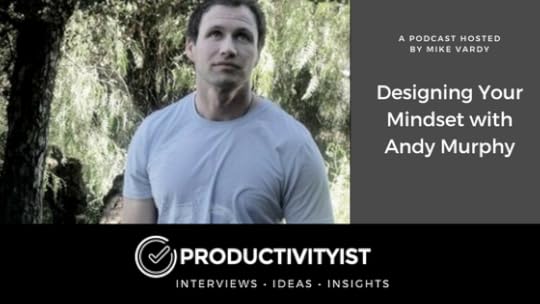
On this episode of the podcast, I spoke with Andy Murphy, the founder of Mindset by Design. Andy has helped world champion athletes, multi-millionaire entrepreneurs, Hollywood producers and actors, and even royalty design their mindsets. We discussed what changing and designing your mindset can do for you, how NLP can help you when it is used for good, why it matters who is in your network, and more.
Here are a few highlights from the show:
Where most people get stuck regarding mindset
What neuro-linguistic programming is
Removing confirmation bias
Why it is important to train ourselves to in each area of our life
Our default setting is whatever is safe
When we grow, our network changes as well
Relevant Links:
Mindset by Design
Andy Murphy | Twitter
Thanks for listening. If you enjoyed the show don’t forget to subscribe so you don’t miss a single episode. Until next time remember to stop guessing…and start going!
If you’re interested in supporting the podcast and receiving exclusive content while doing so, you’ll want to check out the patrons-only version of The Productivityist Podcast on Patreon. Also, remember to leave The Productivityist Podcast a rating and review on iTunes, or on whatever platform you’re listening to. I read every single bit of feedback we receive. I want to make this show better and with your help I can do that. If you’d just like to support the podcast on its own, you can do so here.
The post Designing Your Mindset with Andy Murphy appeared first on Productivityist.



